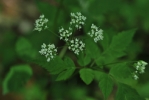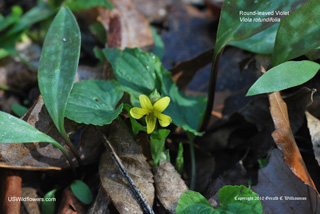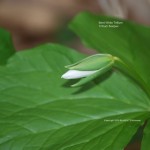On Saturday I participated in the Georgia Botanical Society outing to The Pocket at Pigeon Mountain, led by Mike Christison. I’m a new member of the BotSoc, as they call it, and this membership in this organization is already paying dividends in many ways. In addition to showing me two more wildflowers sites on Pigeon Mountain, I picked up two new species at The Pocket. One of those was the Roundleaf Yellow Violet.
Tag Archives: White Trillium
04/25/2009 The Pocket at Pigeon Mountain
 For those who were hoping for, as Ed Sullivan would have put it, “A Really Big Shew,” the time has passed in 2009. However, that is relative to The Pocket, and the abundance of wildflowers still exceed what you’ll find in many areas. While the dominant flower along the Shirley Miller Wildflower Trail seems to be Sweet Cicely right now, a species that isn’t exactly ‘showy,’ several of the “signature species” could still be found on Saturday, 4/25.
For those who were hoping for, as Ed Sullivan would have put it, “A Really Big Shew,” the time has passed in 2009. However, that is relative to The Pocket, and the abundance of wildflowers still exceed what you’ll find in many areas. While the dominant flower along the Shirley Miller Wildflower Trail seems to be Sweet Cicely right now, a species that isn’t exactly ‘showy,’ several of the “signature species” could still be found on Saturday, 4/25.
04/11/2009 The Pocket – Status Update
 To avoid crowds like those that were on the Shirley Miller Trail at The Pocket on Pigeon Mountain last week, I headed down there early Saturday morning, arriving at the parking area shortly after 8 AM. The sky was overcast, but the wind was low – a good situation for wildflower photography. My first stop was the dogwood tree beside the parking area.
To avoid crowds like those that were on the Shirley Miller Trail at The Pocket on Pigeon Mountain last week, I headed down there early Saturday morning, arriving at the parking area shortly after 8 AM. The sky was overcast, but the wind was low – a good situation for wildflower photography. My first stop was the dogwood tree beside the parking area.
04/04/2009 The Pocket – CVPC Keenagers
 Due to rain and obligations, it had been 9 days since I’d been down to The Pocket at Pigeon Mountain. Today was the Chattanooga Valley Presbyterian Church’s Keen-agers’ annual (I think) wildflower hike at The Pocket, so at 10 AM I joined the other folks in my age group at the church, and soon we headed on down to Pigeon Mountain. I returned from the hike with 381 photographs; two of them with people in them. After an initial run through the photographs, I’ve deleted about 150 of them; both photos of people remain.
Due to rain and obligations, it had been 9 days since I’d been down to The Pocket at Pigeon Mountain. Today was the Chattanooga Valley Presbyterian Church’s Keen-agers’ annual (I think) wildflower hike at The Pocket, so at 10 AM I joined the other folks in my age group at the church, and soon we headed on down to Pigeon Mountain. I returned from the hike with 381 photographs; two of them with people in them. After an initial run through the photographs, I’ve deleted about 150 of them; both photos of people remain.
03/21/2009 The Pocket
Changes are occurring every day at The Pocket. Probably the biggest news is that there are a couple of white trillium that are near opening, with one open enough to see the interior of the blossom (T. flexipes, probably.) Continue reading


